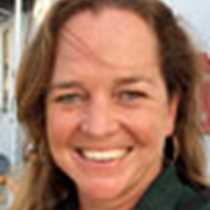Española Island
The last day on our unforgettable expedition through the Galápagos was spent on one of the very first islands to be created, all the way to the Southeast of the archipelago. Once a towering volcano such as those we observed in the West, Española has relentlessly been dragged away from the hotspot that fed it by the movement of the underlying tectonic plate, the Nazca Plate. It thus went extinct, and gradually started to sink down into the mantle as the lithosphere below was no longer swollen by the heat of the hotspot. In addition to this, wind and sea took their toll over the ages, and all that is now left is a low, flat, small island that will eventually disappear altogether.
The scenery on this island is different than that of the other islands, as the southern façade of the island is made up of towering cliffs facing into the wind. Blow holes sent sea spray sky high, and this geography is the perfect take off and landing strip for large numbers of sea birds.
Among the most spectacular of the denizens of Española are the brilliantly-white Nazca boobies, the largest of the three booby species that inhabit the Galápagos. This sea bird is closely related to the more pantropical masked booby, but years of research on this very island led a scientist from Princeton University to declare the Galápagos masked booby as a different species, found in the very restricted area of the Nazca Plate: from Galápagos to the coast of Ecuador and Northern Peru, hence its new name.
It was truly an unforgettable experience to be walking among colonies of hundreds of sea birds, all completely oblivious to our presence.
The northern coasts of the island are less spectacular but far more welcoming, as these are gently sloping and covered in white sandy beaches. This is what allows us access to the island, however, as well as a wonderful morning spent swimming, snorkelling and basking in the sun among sea lions on a wonderful white sandy beach.
We leave the islands tomorrow, our hearts filled with fond memories and joy that natural areas such as these still exist in an ever-more industrialized world. Hopefully experiences here will inspire all that come to strive to maintain contact with nature in every aspect of their lives.
The last day on our unforgettable expedition through the Galápagos was spent on one of the very first islands to be created, all the way to the Southeast of the archipelago. Once a towering volcano such as those we observed in the West, Española has relentlessly been dragged away from the hotspot that fed it by the movement of the underlying tectonic plate, the Nazca Plate. It thus went extinct, and gradually started to sink down into the mantle as the lithosphere below was no longer swollen by the heat of the hotspot. In addition to this, wind and sea took their toll over the ages, and all that is now left is a low, flat, small island that will eventually disappear altogether.
The scenery on this island is different than that of the other islands, as the southern façade of the island is made up of towering cliffs facing into the wind. Blow holes sent sea spray sky high, and this geography is the perfect take off and landing strip for large numbers of sea birds.
Among the most spectacular of the denizens of Española are the brilliantly-white Nazca boobies, the largest of the three booby species that inhabit the Galápagos. This sea bird is closely related to the more pantropical masked booby, but years of research on this very island led a scientist from Princeton University to declare the Galápagos masked booby as a different species, found in the very restricted area of the Nazca Plate: from Galápagos to the coast of Ecuador and Northern Peru, hence its new name.
It was truly an unforgettable experience to be walking among colonies of hundreds of sea birds, all completely oblivious to our presence.
The northern coasts of the island are less spectacular but far more welcoming, as these are gently sloping and covered in white sandy beaches. This is what allows us access to the island, however, as well as a wonderful morning spent swimming, snorkelling and basking in the sun among sea lions on a wonderful white sandy beach.
We leave the islands tomorrow, our hearts filled with fond memories and joy that natural areas such as these still exist in an ever-more industrialized world. Hopefully experiences here will inspire all that come to strive to maintain contact with nature in every aspect of their lives.




